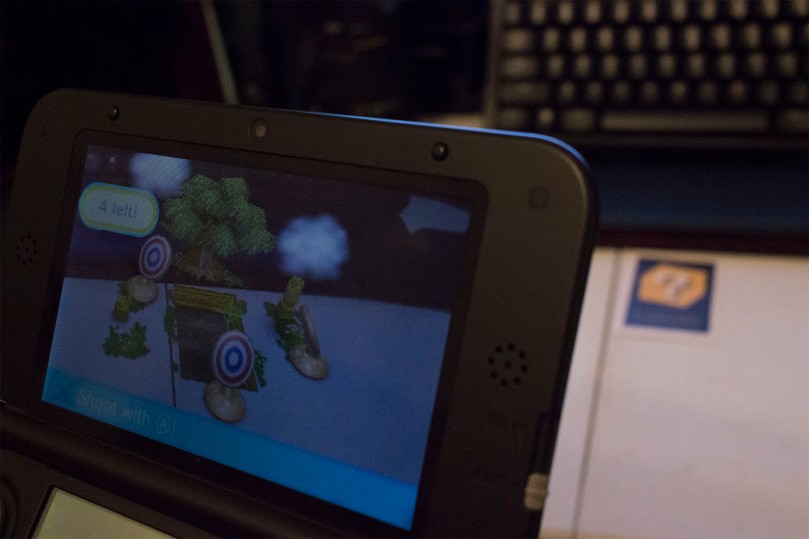Nintendo 3DS handheld game consoles were bundled with a set of Augmented Reality target cards, the device had a program preinstalled which would use the cameras to see the target games to allow the user to play various minigames.
One of the games involved the player firing pellets at targets, they would have to move the device around in the real world space to allow them to see the 3D models in the game from different angles and see more targets. The game would also make other changes to the real world seen through the screen, such as adding objects like trees, a pit, statues and a live dragon to the environment.
The minigames add a bit of fun and novelty to the device, even if they are very basic. It can be something that attracts the attention of a group and can get that group as a whole to engage with the device rather than the original user alone. A lot of these minigames involve the player moving the device around the target card or performing specific motions with the device to register actions in the game, using the accelerometer and gyro sensor in the device.
However it isn’t perfect and the issues come down to the hardware. The camera sensors in the device are pretty awful and in any area that isn’t direct sunlight on a summer’s day a lot of noise is brought into the image. There is a noticeable amount of latency between what happens in the real world and what the user sees on the screen and the field of view from the lenses is very narrow which can make the experience feel cramped. All of this doesn’t render the AR games unplayable but it is noticeable. Another problem is that often when moving the device, it can lose track of the AR card and will require the player to stop what they were doing in the game and give the device time to see the target again. An incident like this isn’t common but it’s something that can happen, especially if you’re not in a very well lit room.
The program used to interact with the AR target cards and the cards them selves are included with the device. When loading the program, instructions are given to the user to aid them with setting up the environment and if the player loses connection to the card the device assists them with reconnecting. Taking this into account, alongside the nature of the minigames and the device being marketed to a wider audience, it can be assumed that this example AR was designed with first time AR users in mind. These users would want to engage with the device and the AR game actively, completing objectives and moving around the real world to make changes to the AR environment. There is the possibility of the user being in a group when using the product, not only is this a possibility to have more users engage with the product in one scenario, this is also a chance to get other people interested in the product and possibly make more sales. Users would be most likely to watch or read information about the game online through social media or websites, they would also talk to peers to gain information about the AR game as well. Methods such as these would be the most effective at making them try or buy the product. While everything needed to access the AR experience is included with the 3DS, the device its self costs the user money so the user is still paying to access the AR content.

F1: A photo from the target game. In this level the player would move the console around the card to hit the targets, and then move it above the card to get a birds eye view so they can see into the pit and hit the target inside it.